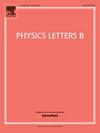Role of multi-phonon and high-spin states on the quasi-elastic barrier distributions of massive systems
IF 4.5
2区 物理与天体物理
Q1 ASTRONOMY & ASTROPHYSICS
引用次数: 0
Abstract
Back-angle quasi-elastic (QE) scattering provides critical barrier information in massive nuclear reactions leading to the synthesis of superheavy nuclei. The shapes and peaks of QE barrier distributions serve as fingerprints of nuclear structures and reaction dynamics. Couplings to collective movements can lead to distinctive peaks in the barrier distributions, but the role of multi-phonon and high-spin states has not been thoroughly investigated. In this work, we extend the high-accuracy R-matrix method and the finite element method to solve coupled-channel equations for massive systems. These two methods are demonstrated to be more stable than the widely used modified Numerov method and allows us to include more vibrational and rotational couplings. Using the reactions + and as examples, calculations show that multi-phonon and high-spin states significantly smooth the barrier distributions, improving the agreement with experimental data. The comparison between the coupled-channel results and those obtained from the orientation average formula is examined. This work can advance the study of superheavy element synthesis by providing reliable barrier information and capture cross sections based on constraints from QE reactions.
多声子和高自旋态对大质量体系准弹性势垒分布的作用
后角准弹性(QE)散射在导致超重核合成的大质量核反应中提供了关键的势垒信息。QE势垒分布的形状和峰可以作为核结构和反应动力学的指纹。与集体运动的耦合可以导致势垒分布的独特峰值,但多声子和高自旋态的作用尚未得到充分研究。本文将高精度r矩阵法和有限元法推广到求解大质量系统的耦合通道方程。这两种方法被证明比广泛使用的修正Numerov方法更稳定,并且允许我们包括更多的振动和旋转耦合。以Ti48+Pb208和V51+248Cm反应为例,计算表明,多声子和高自旋态显著平滑了势垒分布,提高了与实验数据的一致性。对耦合信道计算结果与取向平均公式计算结果进行了比较。这项工作可以通过提供可靠的势垒信息和捕获基于QE反应约束的截面来推进超重元素合成的研究。
本文章由计算机程序翻译,如有差异,请以英文原文为准。
求助全文
约1分钟内获得全文
求助全文
来源期刊

Physics Letters B
物理-物理:综合
CiteScore
9.10
自引率
6.80%
发文量
647
审稿时长
3 months
期刊介绍:
Physics Letters B ensures the rapid publication of important new results in particle physics, nuclear physics and cosmology. Specialized editors are responsible for contributions in experimental nuclear physics, theoretical nuclear physics, experimental high-energy physics, theoretical high-energy physics, and astrophysics.
 求助内容:
求助内容: 应助结果提醒方式:
应助结果提醒方式:


